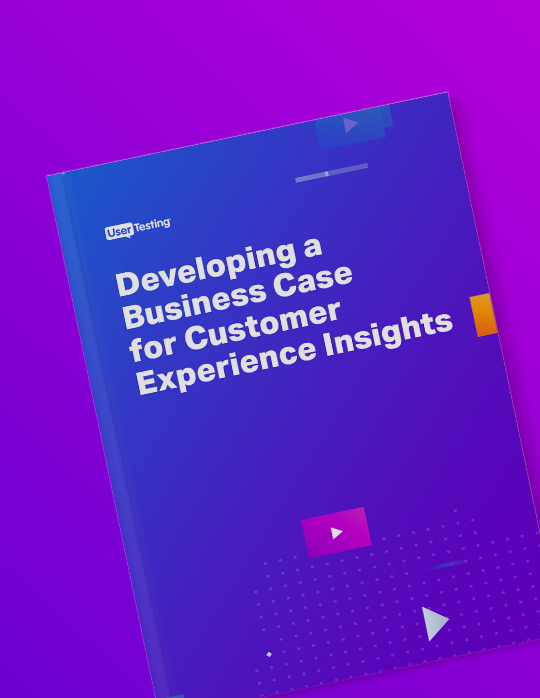
Why every team should care about human insights

It’s no secret that the Age of the Customer is in full swing and showing no signs of slowing down. Consumers understand the power that they have with brands and their expectations continue to rise. As a result, customer-centric companies are relying upon human insights to better understand their customers and build better products and experiences.
The field of experience design and research is evolving quickly and it’s not hard to imagine that human insights could soon be the new CX. Getting ahead of these industry shifts can be a competitive advantage for many organizations, but it helps to understand why insights from customers are so important to everyone in an organization, and how they contribute to better products and experiences.
To help identify how human insights uniquely help various teams, we looked to our own experts in product management, research, design, marketing, and executives to understand the impact that connecting with customers can have on their work.
Before we dig into why human insights are so important, it’s helpful to review what they are—and what they’re not.
What are human insights?

At its core, human insight is the “why” behind our actions. It’s not the quantitative data, but rather, how that data came to be. Human insight is looking beyond the data to gain a better understanding of an experience.
Human insight requires emotional understanding and empathy, which means it’s not something you can learn from traditionally quantitative methods. A survey, for example, will give you data that tells you what’s happening—but it can’t tell you why.
While having explicit definitions of various disciplines or methods can be helpful, they’re also limiting. Incorporating a focus on human insights helps bring the whole human at the receiving end of an experience back into the picture.
Human insights include everything you’d expect from UX and CX disciplines, but as a larger umbrella, helps remind teams and companies what their real goal should be—creating products and experiences for a real human being.
Why product teams need human insights
Product teams are dependent upon fast, actionable information to drive product decisions. The need for speed and accuracy is a challenging combination that leads some Product Managers to view human insight as a luxury, rather than a necessity.
The reality is quite the opposite. Product Managers that forego conducting regular customer research miss out on important insights and validation of ideas and designs.
UserTesting’s Director of Product, Tanya Koshy notes that human insight gives companies a strong competitive advantage over those that don't,
“Gathering human insight helps you understand the nuances and complexities of customer behavior that other companies might miss.”
“You understand the "why" behind their behavior. You hear their needs, pain, and emotion—that's really important inspiration when building products. By leveraging human insights we've sped up our time to finding and delivering successful products. Investing a ton of time in building products that ultimately don’t resonate with your customers is not worth it.”
That competitive edge is in large part due to the ease and speed at which human insights can be incorporated into any and all stages of the development cycle, informing better decisions at every step of the way. Tanya adds,
“Human insights help me quickly and easily validate my product ideas at every stage of development. They give me evidence I can use to help me build a shared understanding of our customers, to get buy-in across the company, for my product ideas.”
Why researchers need human insights
When it comes to research, evidence is key. It’s crucial to the role of a researcher that they provide deep insight into patterns and ways to better both products and the overall experience.
Researchers act as a compass for the foundation and direction of a company. If there isn’t any evidence to back a product or idea, why follow it? Everyone needs what a researcher can provide but more often than not there aren’t enough researchers to go around.
UserTesting’s Engagement Director, Lija Hogan shares how human insights can build empathy within an organization and guide them in the right direction,
“The most effective way to build empathy and understanding with people is by having an ongoing conversation with them.”
“Ask them directly for their feedback. There is no more effective way to convince people of the urgency and reasoning behind making change than listening to and watching them use your product. Show and tell is a natural way to tell a story, and human insights support it well.”
By being able to connect with your customers and understand what they need, you’re less likely to waste time and energy on products that will never be successful and focus on what works. When it comes to research many ask whether qualitative customer research is enough.
Human insight provides teams with an extra layer of empathy and context that usually isn’t there with just one type of research. But more importantly, it helps guide your organization by keeping the customers at the center of everything they do.
Why designers need human insights
Designers are responsible for more than the logos you see—they’re crucial to ideating what a product will look and feel like to the end user. They’re integral to bringing an idea to life, but their work doesn’t just end when a product is launched, it continues on through its multiple iterations.
Keeping in tune with their customers through human insights plays a key role in designing products that delight. As UserTesting’s Senior Designer, Darren Wong says,
“Designers work best when they understand a customer’s problem and needs. Human insight takes out the guesswork and helps you focus on solving your customers’ problems.”
Great design requires getting multiple stakeholders on the same page so they can deliver the best possible product. Human insights help provide unbiased from the people who matter most, your customers. Darren puts it best,
“Human insight helps me get alignment from my product and engineering stakeholders. Showing a clip of a frustrated customer is an easy way for the whole team to build empathy and get alignment on solving a problem. Instead of making assumptions about what our customers are doing, I can see and hear them as they navigate through our product. This gives me accurate and actionable feedback on the areas that I can make improvements.”
Many times it’s easy to get caught up in a heatmap or a survey, but without the context of human insight you end up designing blind, hoping that you’ll hit the right target.
Why marketers need human insights
Marketers aren’t just responsible for the amazing brand campaigns you see, they’re usually the first touchpoint for any potential customer. So why are human insights necessary to marketers?
Our VP of Market Strategy, Michael Mace shares a few thoughts on the topic,
“As a marketer, it’s important for me to connect with customers both emotionally and rationally. But it’s hard to keep in mind the things that customers care about—as opposed to what I want them to care about, or the consensus that develops within companies and industries. Fresh human insights—fast and constant—keep me grounded in customer reality and help me serve their real needs.”
When you’re able to connect with your customers you’re able to build the products that fit into their lives. As Mike explains it,
“It’s a feedback loop: Listen to them talk about their lives, work with our product team on what we can build for them, and then test messages describing what we’ve built. When the loop works right, we can rapidly meet customer needs.”
By staying in touch with your customers it creates a deep connection and understanding of who your customers are. It’s something that can’t be faked and will be reflected in everything you do. Mike put it best,
“You can’t fake empathy. If you treat your customers like a set of numbers, you shouldn't be surprised when they view your company as a faceless monolith. Numbers are great for a lot of things, but they can't give you a human connection."
Why executives need human insights
One major challenge companies face in an increasingly digital world is continuously empathizing with the people interacting with their products or services.
Despite significant investment in digital tools and platforms, many organizations still struggle to meet evolving customer expectations. This persistent disconnect—known as the experience gap—arises from common issues such as a lack of timely customer feedback, internal misalignment, and a fundamental misunderstanding of user needs. While 87% of companies believe they deliver exceptional customer experiences, only 11% of customers agree. In today’s competitive landscape, closing this gap is essential—especially as companies that lead in customer experience grow their value at five times the rate of their peers.
Noting the importance of human insights, UserTesting’s Chief Insights Officer, Janelle Estes said,
“Our research and experience with customers over the past decade shows that leveraging human insight to understand consumer sentiment and preference in order to create a superior customer experience can ultimately determine success or failure for a product or company.”
It’s easy for organizations and executives to become disconnected with their customers. Empathy doesn’t stop at creating a persona or a product—it’s constant and comes from the top-down. When executives are able to continually connect with their customers they’re able to prioritize putting the customer first. The more you can bridge the empathy gap, the deeper your connection to your customers will be. At the end of the day, it can only help the bottom line for your business.
Human insight goes beyond data
While the insights themselves may be mostly qualitative in nature, that doesn’t mean they can’t be paired with quantitative data—they should. Together, they provide a more holistic understanding of your customer.
No matter what your role may be, you can’t underestimate the value of cultivating empathy for your customers. In this technology-driven world, there’s no substitute for real human connection. The organizations that keep their customers at the heart of their business will continue to stay ahead of the curve.
Want to learn more?
If you’d like to learn how UserTesting can help you understand your customers through on-demand human insight, contact us here.
In this Article






